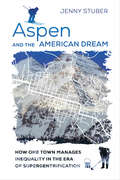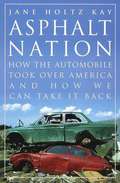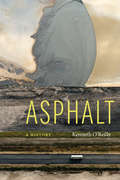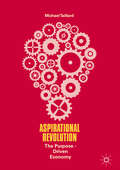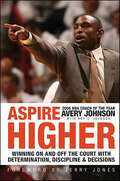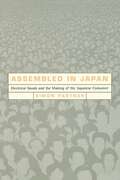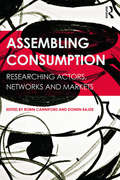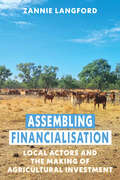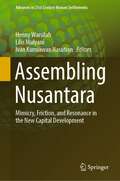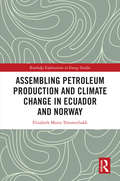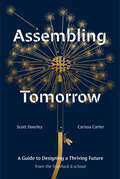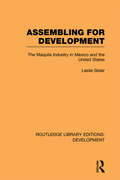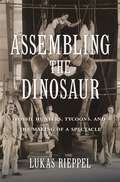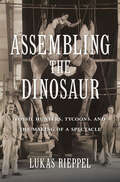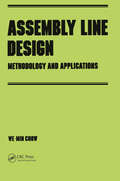- Table View
- List View
Aspen Skiing Company (D)
by Michael W. Toffel Stephanie Van SiceHaving begun improving the environmental performance of its own operations, Aspen Skiing Company is considering "greening" its supply chain and lobbying for greenhouse gas regulations. A world-renowned ski resort vulnerable to global climate change, Aspen's activities often garner media attention, which can promote its causes. But these initiatives, which attempt to compel other firms to improve their environmental performance, risk a public relations backlash and charges of "greenwashing" given that Aspen's ski resorts are themselves environmentally intensive operations.
Aspen Technology, Inc.: Currency Hedging Review
by Peter Tufano Cameron PoetzscherThe chief financial officer of a rapidly growing U.S.-based software firm that sells its process-control software to industrial users around the globe must review the goals, strategies, and policies of the firm's currency hedging program. This review is prompted by changes in the firm's business, notably its acquisition of a United Kingdom subsidiary, other growing overseas expenses, and its recent initial public offering.
Aspen and the American Dream: How One Town Manages Inequality in the Era of Supergentrification
by Jenny StuberHow is it possible for a town to exist where the median household income is about $73,000, but the median home price is about $4,000,000? Boring into the "impossible" math of Aspen, Colorado, Stuber explores how middle-class people have found a way to live in this supergentrified town. Interviewing a range of residents, policymakers, and officials, Stuber shows that what resolves the math equation between incomes and home values in Aspen, Colorado—the X-factor that makes middle-class life possible—is the careful orchestration of diverse class interests within local politics and the community. She explores how this is achieved through a highly regulatory and extractive land use code that provides symbolic and material value to highly affluent investors and part-year residents, as well as less-affluent locals, many of whom benefit from an array of subsidies—including an extensive affordable housing program—that redistribute economic resources in ways that make it possible for middle-class residents to live there.Stuber further examines how Latinos, who provide much of the service work in Aspen and who tend to live outside the town, fit into the social geography of one of the most unequal places in the country. Overall, Stuber argues that the Aspen's ability to balance the interests of its diverse class constituencies is not a foregone conclusion; rather, it is the result of efforts by local stakeholders—citizens, government, developers, and vacationers—to preserve the town’s unique feel and value, and "keep Aspen, Aspen" in all its complex dynamics.
Asperger Syndrome and Employment: Adults Speak Out about Asperger Syndrome
by Chris Mitchell Alexandra Brown Dean Worton Luke Beardon Neil Shepherd John Biddulph Anne Henderson Stephen William Cornwell Stuart Vallentine Vicky Bliss Emma Beard Genevieve Edmonds Giles Harvey Philip Bricher Pj Hughes Stephen Jarvis Mark HaggartyEmployment is an important part of a healthy, balanced and fulfilling life but less than 20 per cent of people with Asperger Syndrome (AS) are in work at any one time. The adults with AS in this book explore the issues surrounding employment, providing advice and insights for others with AS, as well as their employers and colleagues. Drawing on personal experience and lessons learned, Asperger Syndrome and Employment looks at: * the transition from education to employment, * the importance of matching skills to career choices, * practical coping strategies for employees with AS in the workplace, * advice for employers, including the need to make `reasonable adjustments' to avoid discrimination, * ways in which employment services ought to work for people with AS. This is essential reading for adults with AS, their family and friends, employment services and career advisers, and companies needing to know how, in practical terms, to accommodate employees with AS.
Asphalt Nation: How the Automobile Took Over America and How We Can Take It Back
by Jane Holtz KayAsphalt Nation is a major work of urban studies that examines how the automobile has ravaged America's cities and landscape, and how we can fight back. The automobile was once seen as a boon to American life, eradicating the pollution caused by horses and granting citizens new levels of personal freedom and mobility. But it was not long before the servant became the master-- public spaces were designed to accommodate the automobile at the expense of the pedestrian, mass transportation was neglected, and the poor, unable to afford cars, saw their access to jobs and amenities worsen. Now even drivers themselves suffer, as cars choke the highways and pollution and congestion have replaced the fresh air of the open road. Today our world revolves around the car-- as a nation, we spend eight billion hours a year stuck in traffic. In Asphalt Nation, Jane Holtz Kay effectively calls for a revolution to reverse our automobile-dependency. Citing successful efforts in places from Portland, Maine, to Portland, Oregon, Kay shows us that radical change is not impossible by any means. She demonstrates that there are economic, political, architectural, and personal solutions that can steer us out of the mess. Asphalt Nation is essential reading for everyone interested in the history of our relationship with the car, and in the prospect of returning to a world of human mobility.
Asphalt: A History
by Kenneth O'ReillyLa Brea Tar Pits once trapped prehistoric mammals. Today that killer has a chemical cousin in the Athabasca oil sands of Alberta, Canada—immense deposits of natural asphalt destined for upgrading to synthetic crude oil. If the harvesting of this natural asphalt continues unabated, we might find ourselves stuck in a muck of a different kind. Humanity has used asphalt for thousands of years. This humble hydrocarbon may have glued the first arrowhead to the first shaft, but the changes wrought by this material are most dramatic since its emergence as pavement. Since the 1920s the automobile and blacktop have allowed unprecedented numbers of Americans to experience the beauty of their continent from the Adirondacks to the Rockies and beyond, to Big Sur and the Pacific Coast Highway. Blacktop roads, runways, and parking lots constitute the central arteries of our environment, creating a distinct &“political territory&” and a &“political economy of velocity.&” In Asphalt: A History Kenneth O&’Reilly provides a history of this everyday substance. By tracing the history of asphalt—in both its natural and processed forms—from ancient times to the present, O&’Reilly sets out to identify its importance within various contexts of human society and culture. Although O&’Reilly argues that asphalt creates our environment, he believes it also eventually threatens it. Looking at its role in economics, politics, and global warming, O&’Reilly explores asphalt&’s contribution to the history, and future, of America and the world.
Aspiration and Ambivalence
by Vanda Felbab-Brown Bruce RiedelAfter more than a decade of great effort and sacrifice by America and its allies, the Taliban still has not been defeated, and many Afghans believe that a civil war is coming. Aspiration and Ambivalence analyzes the U.S. and international efforts in Afghanistan and offers detailed recommendations for dealing with the precarious situation leading up to the 2014 transition to Afghan control and beyond. Vanda Felbab-Brown argues that allied efforts in Afghanistan have put far too little emphasis on good governance, concentrating too much on short-term military goals to the detriment of long-term peace and stability. The Western tendency to ally with bullies, warlords, smugglers, and other shady characters in pursuit of short-term military advantage actually empowers the forces working against good governance and long-term political stability. Rampant corruption and mafia rule thus persist, making it impossible for Afghans to believe in the institutional reforms and rule of law that are clearly necessary. This must change- otherwise, the chances of building responsive and sustainable governmental structures are slim, indeed.Felbab-Brown combines thorough research and analysis with vivid personal accounts of her time spent in the war-torn nation-powerful vignettes illustrating the Afghan aspirations for peace, stability, and sovereignty and the stubborn obstacles to securing them."The year 2014 will mark a critical juncture in Afghanistan's odyssey. After more than a decade of arduous fighting and political involvement, the U.S. and international presence there will be significantly reduced and circumscribed. Although the international community has committed itself not to abandon Afghanistan as it did in the 1990s, the onus will be on the Afghan government to provide for the security of the country, its economic development, and governance that attempts to meet the needs of the Afghan people. Difficult challenges, major unresolved questions, and worrisome trends surround all three sets of processes. The biggest hole in the U.S. strategy and international efforts to stabilize the country is the failure to adequately address the country's fractured and brittle political system and very poor governance."-from Aspiration and Ambivalence
Aspirational Revolution: The Purpose-Driven Economy
by Michael TaillardThis book illustrates how global economic progress has reached its upper limit under the current economic paradigm, and how the next major revolution in global progress will rely on our ability to tap into the collective knowledge of the "everyday genius" to drive innovation, free market competition, artistic influence, and other advances that will allow humanity to overcome its greatest challenges. This volume proposes a grant-based program that will allow innovators to pursue their passions and benefit society as a whole. Such a program will reflect the end of the industrial age, when technology is satisfying many basic needs and creating space for individuals to pursue meaningful, fulfilling careers with the potential to improve our quality of life. Our current economic state mirrors the beginnings of the Agricultural Revolution and Industrial Revolution, and Aspirational Revolution shows how the immediate future will redefine what it means to be human by revolutionizing the manner in which we acquire and utilize the resources necessary for our continued survival. This book is the catalyst by which this transition will occur, providing the models upon which new paradigms will be built - a brand new conception of fundamental economic theory.
Aspire Higher: Winning On and Off the Court with Determination, Discipline, & Decisions
by Roy S. Johnson Avery JohnsonAvery Johnson is a coach, a teacher, and sometimes even a preacher, but most of all, he is a motivator, driving his team with the same fiery passion that allowed him to earn his championship credentials as an NBA player. Growing up in New Orleans's Lafitte Housing Project, he was never the biggest, fastest, or strongest, but by the strength of his will and character, he persevered. Now he offers the lessons he learned on his journey from the bottom of the bayou to the heights of success in this inspiring book. Aspire Higher is the essential game plan for reaching your goals. Johnson begins by outlining what it takes to get to the top: determination and discipline provide the foundation that allows you to make the right decisions, on the basketball court or in the boardroom. The goal isn't just to be successful, however; it's also about caring for other people along the way. “I care about you more than I care about winning,” Johnson often tells his players.Avery Johnson's personal and professional experiences illuminate crucial lessons, inspiring readers just as he has inspired teammates and players. His spirited message is for anyone looking for the tools and secrets of success in business, school, sports, and more—anyone looking to aspire higher.
Aspiring Minds
by Marco Iansiti Christine Snively Karim R. LakhaniBy 2015, India-based employment assessment and certification provider Aspiring Minds had helped facilitate over 300,000 job matches through its assessment tools. Aspiring Minds' flagship product, the Aspiring Minds Computer Adaptive Test (AMCAT), used machine learning algorithms to evaluate the abilities of job seekers and provide feedback by measuring not only skills and knowledge, but also personality and behavior traits. Since its founding in 2007, the company developed several new assessment products, including SVAR, a spoken-English evaluation, Automata, a programming skills evaluator, a customer service test, and TESLA, a suite of products that assessed and provided certification for vocational skills. The company had recently expanded into parts of Africa, the Middle East, the Philippines, the U.S., and most recently, China. Aspiring Minds had seen success as a business-to-business (B2B) entity, creating and selling technology products geared towards industry verticals. By 2015 the business-to-consumer (B2C) side of the business in India had been quite successful as well, generating revenues equal to that of the B2B side. As Aspiring Minds worked to establish a presence in China, co-founders Himanshu and Varun Aggarwal considered whether a B2B or B2C approach would best help the company achieve scale.
Assemble the Dedicated Team: Seven Common Traps to Avoid When Building an Innovation Team
by Chris Trimble Vijay GovindarajanIt's surprisingly easy for companies to stumble when they assemble a dedicated team to work on an innovation initiative. In this chapter, the authors suggest three initial steps: 1) Identify the skills you need; 2) Hire the best people you can find; and 3) Match the organizational model to the dedicated team's job. The authors then list the seven most common pitfalls innovation leaders are likely to encounter as they assemble their teams; for example, having a bias for insiders, applying existing formal definitions of roles and responsibilities, or failing to allow the team to define its own culture. The chapter concludes with three examples of companies-Dow Jones (now News Corporation), Thomson Corporation (now Thomson Reuters), and Lucent (now Alcatel-Lucent)-that have built winning innovation teams. This chapter was originally published as Chapter 2 of "The Other Side of Innovation: Solving the Execution Challenge."
Assembled in Japan: Electrical Goods and the Making of the Japanese Consumer
by Simon PartnerAssembled in Japan investigates one of the great success stories of the twentieth century: the rise of the Japanese electronics industry. Contrary to mainstream interpretation, Simon Partner discovers that behind the meteoric rise of Sony, Matsushita, Toshiba, and other electrical goods companies was neither the iron hand of Japan's Ministry of International Trade and Industry nor a government-sponsored export-led growth policy, but rather an explosion of domestic consumer demand that began in the 1950s.This powerful consumer boom differed fundamentally from the one under way at the same time in the United States in that it began from widespread poverty and comparatively miserable living conditions. Beginning with a discussion of the prewar origins of the consumer engine that was to take off under the American Occupation, Partner quickly turns his sights on the business leaders, inventors, laborers, and ordinary citizens who participated in the broadly successful effort to create new markets for expensive, unfamiliar new products.Throughout, the author relates these pressure-cooker years in Japan to the key themes of twentieth-century experience worldwide: the role of technology in promoting social change, the rise of mass consumer societies, and the construction of gender in advanced industrial economies.
Assembling Consumption: Researching actors, networks and markets
by Domen Bajde Robin CannifordAssembling Consumption marks a definitive step in the institutionalisation of qualitative business research. By gathering leading scholars and educators who study markets, marketing and consumption through the lenses of philosophy, sociology and anthropology, this book clarifies and applies the investigative tools offered by assemblage theory, actor-network theory and non-representational theory. Clear theoretical explanation and methodological innovation, alongside empirical applications of these emerging frameworks will offer readers new and refreshing perspectives on consumer culture and market societies. This is an essential reading for both seasoned scholars and advanced students of markets, economies and social forms of consumption.
Assembling Financialisation: Local Actors and the Making of Agricultural Investment
by Zannie LangfordFarmers, Indigenous organisations, government and private-sector intermediaries from remote Northern Australia often negotiate with private finance capital to gain funds for agricultural development.The concept of financialisation is used to explore the drivers and effects of agrifood restructuring in the area, while assemblage theory is applied to position local actors as potential sites of power in negotiating connections between local spaces and global finance. This book demonstrates that while financialisation is a useful signifier of patterns of global change, it is assembled by a diverse range of often contradictory work.
Assembling Nusantara: Mimicry, Friction, and Resonance in the New Capital Development (Advances in 21st Century Human Settlements)
by Lilis Mulyani Henny Warsilah Ivan Kurniawan NasutionToday, the new Indonesian capital city, Nusantara, planning is being anticipated as “representing national identity,” “a model city,” or “a gift to the world,” and many other extraordinary labels. This book examines the reality of an ongoing developmental transformation of the Nusantara beyond those labels. It approaches its assemblage of humans, their works (plans, documents, policies, and others), non-human objects (biodiversity, landscape, geography, physical infrastructure, buildings, and public spaces), processes, social relationships, social infrastructures, and others. It is organized into three themes—mimicry, friction, and resonance. The mimicry illustrates the similarities (and differences) between Nusantara and other capital cities in urban narratives, imageries, and forms. The friction studies how Nusantara moves actors who do not always agree, processes that do not always align or collaboration between diverse contradicting groups that intersect. The resonance observes how Nusantara resonates with, yet communicates its voice toward, the world. The three concepts (originated from geography, anthropology, and sociology) frame the analytics of the various contributions of local and foreign scientists from multiple disciplines. Overall, the book recommends “Otorita Ibu Kota Nusantara” (Nusantara capital city authority) on the current experimentation and implementation of the urban vision and provides a reference for social scientists to study Nusantara. And more broadly, the book offers the current socio-spatial practices of capital city-making in Asia that are valuable for the region.
Assembling Petroleum Production and Climate Change in Ecuador and Norway (Routledge Explorations in Energy Studies)
by Elisabeth Marta TómmerbakkThis book addresses some of the controversies and uncertainties associated with reducing the extensive exploitation of fossil fuels due to their role in global warming. Elisabeth Marta Tómmerbakk explores why a transition towards a post-carbon society is so difficult to accomplish by examining how the relationship between petroleum production and climate change is politically framed and negotiated in contested cases. This question is approached through a process-oriented comparative case study of Lofoten, located in the Norwegian Sea above the Arctic Circle, and Yasuní-ITT (Ishpingo, Tambococha, and Tiputini) located in the Ecuadorian Amazon: regions that both belong to oil-exporting countries with highly oil-dependent economies. Tómmerbakk draws on rich empirical data that includes qualitative interviews with subjects in both countries and applies an Actor-Network Theory framework to show that oil and climate are intricately entangled in knowledge and policy practices. Overall, Assembling Petroleum Production and Climate Change in Ecuador and Norway provides an in-depth examination of how climate science and petroleum extraction are negotiated, adapted, assembled, and coordinated with other national policies and political aims. This book will be of great interest to students and scholars of petroleum production, climate change, environmental policy, and environmental sociology.
Assembling Smartphones: Takt Time Cycle Time?
by Willy Shih Ethan S. BernsteinThe case was prepared to be used as part of a process review in the first year Technology and Operations Management course at HBS. It offers students an opportunity to discuss the context of a manufacturing process choice, and then examine actual production numbers that resulted from a series of choices. While there isn't a traditional case issue, the discussion should focus on the gap between theoretical process designs and the reality of practical implementations, with the impact of operator variability in pace and the complex intertwining with work scope. The case only meant for one discussion pasture to review the Hayes-Wheelwright product-process matrix, and the impact of variability on line performance. While comparative numbers for the process choices are provided, the hope would be to develop students' intuition around why the numbers change so much.
Assembling Tomorrow: A Guide to Designing a Thriving Future from the Stanford d.school (Stanford d.school Library)
by Scott Doorley Stanford d.school Carissa CarterA powerful guide to why even the most well-intentioned innovations go haywire, and the surprising ways we can change course to create a more positive future, by two celebrated experts working at the intersection of design, technology, and learning at Stanford University&’s acclaimed d.school.&“This brilliant book offers a new approach to all creative work that will expand your understanding of what it means to make and open up possibilities you didn&’t know existed—it did for me.&”—Adam Johnson, Pulitzer Prize-winning author of The Orphan Master&’s SonIn Assembling Tomorrow, authors Scott Doorley and Carissa Carter explore the intangible forces that prevent us from anticipating just how fantastically technology can get out of control, and what might be in store for us if we don&’t start using new tools and tactics. Despite our best intentions, our most transformative innovations tend to have consequences we can&’t always predict. From the effects of social media to the uncertainty of AI and the consequences of climate change, the outcomes of our creations ripple across our lives. Time and again, our seemingly ceaseless capacity to create rubs up against our limited capacity to understand our impact. Assembling Tomorrow explores how to use readily accessible tools to both mend the mistakes of our past and shape our future for the better. We live in an era of &“runaway design,&” where innovations tangle with our lives in unpredictable ways. This book explores the off-kilter feelings of today and follows up with actionables to alter your perspective and help you find opportunities in these turbulent times. Mixed throughout are histories of the future, short pieces of speculative fiction that imagine the future as if it has already happened and consider the past with a critical yet hopeful eye so that all of us—as designers of our own futures—can create a better world for generations to come.
Assembling Your Opportunity Portfolio: Allocating Resources Employing an Entrepreneurial Mindset
by Rita Gunther Mcgrath Ian MacmillanIn uncertain times, it's essential that you practice the nimble thought process and discipline that are second nature to successful entrepreneurs. This entrepreneurial mindset will help you build an arsenal of new opportunities. One of the key challenges is figuring out how you are going to appropriately allocate resources to those opportunities that you elect to pursue. As illustrated in this chapter, using real options reasoning to guide your investment of people and resources in new opportunities can allow you to pursue attractive opportunities without burning your organization out and without wasting scarce resources. This chapter is excerpted from "The Entrepreneurial Mindset: Strategies for Continuously Creating Opportunity in an Age of Uncertainty."
Assembling and Managing Project Teams: Realizing Disruptive Potential
by Scott D. Anthony Mark W. Johnson Joseph V. Sinfield Elizabeth J. AltmanOne of the greatest challenges facing managers seeking to create new growth businesses is assembling and managing teams charged with creating new growth. This chapter provides guidelines for senior managers to set up a team for success.
Assembling for Development: The Maquila Industry in Mexico and the United States (Routledge Library Editions: Development #No. 5)
by Leslie SklairFirst published in 1989, this book focuses upon the phenomenon of export-led industrialisation fuelled by foreign investment and technology. He concentrates on Mexico, where US companies have been taking advantage of inexpensive labour to establish "maquila" factories that assemble US parts for export. Through this detailed study of the maquila industry, Sklair charts the progress from the political imperialism of colonial days to the economic imperialism of today.
Assembling the Dinosaur: Fossil Hunters, Tycoons, and the Making of a Spectacle
by Lukas RieppelLukas Rieppel shows how dinosaurs gripped the popular imagination and became emblems of America’s industrial power and economic prosperity during the Gilded Age. Spectacular fossils were displayed in museums financed by North America’s wealthiest tycoons, to cement their reputation as both benefactors of science and fierce capitalists.
Assembling the Dinosaur: Fossil Hunters, Tycoons, and the Making of a Spectacle
by Lukas RieppelA lively account of the dinosaur’s role in Gilded Age America, examining the connection between business, paleontology, and museums.Although dinosaur fossils were first found in England, a series of dramatic discoveries during the late 1800s turned North America into a world center for vertebrate paleontology. At the same time, the United States emerged as the world’s largest industrial economy, and creatures like Tyrannosaurus, Brontosaurus, and Triceratops became emblems of American capitalism. Large, fierce, and spectacular, American dinosaurs dominated the popular imagination, making front-page headlines and appearing in feature films.Assembling the Dinosaur follows dinosaur fossils from the field to the museum and into the commercial culture of North America’s Gilded Age. Business tycoons like Andrew Carnegie and J. P. Morgan made common cause with vertebrate paleontologists to capitalize on the widespread appeal of dinosaurs, using them to project American exceptionalism back into prehistory. Learning from the show-stopping techniques of P. T. Barnum, museums exhibited dinosaurs to attract, entertain, and educate the public. By assembling the skeletons of dinosaurs into eye-catching displays, wealthy industrialists sought to cement their own reputations as generous benefactors of science, showing that modern capitalism could produce public goods in addition to profits. Behind the scenes, museums adopted corporate management practices to control the movement of dinosaur bones, restricting their circulation to influence their meaning and value in popular culture.Tracing the entwined relationship of dinosaurs, capitalism, and culture during the Gilded Age, Lukas Rieppel reveals the outsized role these giant reptiles played during one of the most consequential periods in American history.Praise for Assembling the Dinosaur“A penetrating study of legitimacy and capitalism in the realm of fossils.” —Verlyn Klinkenborg, The New York Review of Books“A solid entry into the growing body of literature on Gilded Age American paleontology, but it is particularly valuable for its contribution to enhancing our understanding of how science and its representation during that period were influenced by, and in turn affected, society as a whole. By incorporating cultural, economic, and scientific developments, Rieppel shines new light on the history of both American paleontology and museum exhibition practice.” —Ilja Nieuwland, Science
Assembling the Startup Team
by Noam WassermanNothing can bedevil a high-potential startup more than its "people problems." These problems typically result from choices that founders make as they add team members to their startup team. Three characteristics of startup teams must be aligned for these teams to function well: relationships, roles, and rewards (the Three Rs). Early decisions that founders make about the Three Rs can significantly affect their startup's direction and success. This note explores some of these choices and their long-term implications.
Assembly Line Design: Methodology and Applications
by We-Min ChowThis book attempts to treat line design and its related subjects in a cohesive manner, with an emphasis on design applications. It discusses general guidelines for setting up assumptions and determining line performance parameters, based on empirical data from literature reports.

